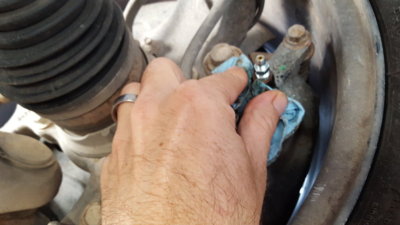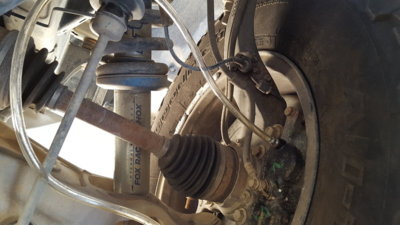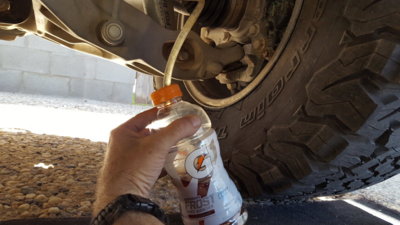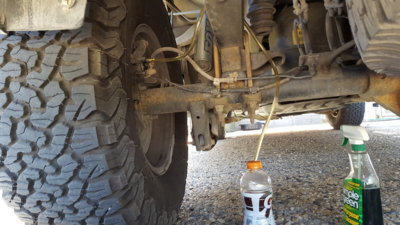So this weekend I upgraded from garden-variety, low-speed high-drag factory brake bleeder screws to Russell Speed Bleeders. These things make bleeding brakes a one-man operation and are well worth investing in if you ever need to bleed the brake lines; for shiny new aftermarket lines or a shiny new factory brake booster (not that these will help bench bleed the master cyl), or just for the hell of it to replace the brake fluid on a high-mile truck (like mine).
Cheapest I could find them was on ebay for $12.99 a pair shipped:
Russell 639590 Speed Bleeder 3/8-24 Thread 1 1/4" Overall Length 2 pcs
Russell 639560 Speed Bleeder 10 mm x 1.0 mm Thread 35 mm Overall Length 2 pcs | eBay
On a '10-14 the fronts use the part # 639590 and the rears are # 639560. You'll need a 3/8" wrench for the fronts and a 7/16" for the rear. From a suggestion in another thread an empty 32oz. Gatorade bottle works great with a hole cut in the cap, and a few feet of 1/4" I.D. clear tubing. I grabbed two quarts of DOT 4 fluid for $17, but barely used more than a quart, and yes factory is DOT 3 and would work fine for a couple bucks less. I used a small hand pump to empty as much of the old fluid out of the brake master cylinder reservoir as I felt safe emptying (go to far and you may need to bench bleed the master cylinder so just take out to within about an inch from the bottom to be safe) since I was replacing as much of the fluid as I could. From that point the speed bleeders installation is pretty straightforward:
1. Fill brake master cylinder reservoir, put on the cap.
2. Start with longest (edit: not shortest as I mistakenly did, thanks for the advise guys) brake line so right rear, locate brake bleeder towards top of caliper, leave the cap on it if present or use one of the ones included with the speed bleeder to prevent brake fluid from going everywhere.
3. Hold rag below bleeder and crack bleeder loose with 3/8" wrench, you should be able to hand spin it out and hand tighten the speed bleeder without losing too much fluid. They are tight but not superhuman torqued in there, whatever you do don't use WD-40 or some shit on them, if you get it on the brake pads they will swell like crazy and a nightmare will ensue.
4. Tighten speed bleeder until it bottoms out, remove cap.
5. Run 1/4" hose over the leaf spring and down to the bleeder (the other end of the hose in the Gatorade bottle cap, for the fronts go up and over the swaybar).
6. Loosen speed bleeder 1/2 turn.
7. Get in truck and pump the brakes 2-4 times (edit: no need to start truck, thanks for the input).
8. Tighten speed bleeder, pop off 1/4" hose carefully and lift to get brake fluid to drain into bottle (that shit peels paint and probably does horrific things to your eyeballs, try not to get it anywhere), replace rubber cap.
9. Top off brake master cylinder.
10. Repeat for left rear, right front, then left rear (rears take 10-20 pumps to push out old fluid if you're replacing fluid, if you lean out the door you can see the brake reservoir as you're pumping the brakes-don't pump it dry).
11. Double check brake master cylinder is at "Full" line.





Cheapest I could find them was on ebay for $12.99 a pair shipped:
Russell 639590 Speed Bleeder 3/8-24 Thread 1 1/4" Overall Length 2 pcs
Russell 639560 Speed Bleeder 10 mm x 1.0 mm Thread 35 mm Overall Length 2 pcs | eBay
On a '10-14 the fronts use the part # 639590 and the rears are # 639560. You'll need a 3/8" wrench for the fronts and a 7/16" for the rear. From a suggestion in another thread an empty 32oz. Gatorade bottle works great with a hole cut in the cap, and a few feet of 1/4" I.D. clear tubing. I grabbed two quarts of DOT 4 fluid for $17, but barely used more than a quart, and yes factory is DOT 3 and would work fine for a couple bucks less. I used a small hand pump to empty as much of the old fluid out of the brake master cylinder reservoir as I felt safe emptying (go to far and you may need to bench bleed the master cylinder so just take out to within about an inch from the bottom to be safe) since I was replacing as much of the fluid as I could. From that point the speed bleeders installation is pretty straightforward:
1. Fill brake master cylinder reservoir, put on the cap.
2. Start with longest (edit: not shortest as I mistakenly did, thanks for the advise guys) brake line so right rear, locate brake bleeder towards top of caliper, leave the cap on it if present or use one of the ones included with the speed bleeder to prevent brake fluid from going everywhere.
3. Hold rag below bleeder and crack bleeder loose with 3/8" wrench, you should be able to hand spin it out and hand tighten the speed bleeder without losing too much fluid. They are tight but not superhuman torqued in there, whatever you do don't use WD-40 or some shit on them, if you get it on the brake pads they will swell like crazy and a nightmare will ensue.
4. Tighten speed bleeder until it bottoms out, remove cap.
5. Run 1/4" hose over the leaf spring and down to the bleeder (the other end of the hose in the Gatorade bottle cap, for the fronts go up and over the swaybar).
6. Loosen speed bleeder 1/2 turn.
7. Get in truck and pump the brakes 2-4 times (edit: no need to start truck, thanks for the input).
8. Tighten speed bleeder, pop off 1/4" hose carefully and lift to get brake fluid to drain into bottle (that shit peels paint and probably does horrific things to your eyeballs, try not to get it anywhere), replace rubber cap.
9. Top off brake master cylinder.
10. Repeat for left rear, right front, then left rear (rears take 10-20 pumps to push out old fluid if you're replacing fluid, if you lean out the door you can see the brake reservoir as you're pumping the brakes-don't pump it dry).
11. Double check brake master cylinder is at "Full" line.





Last edited:





